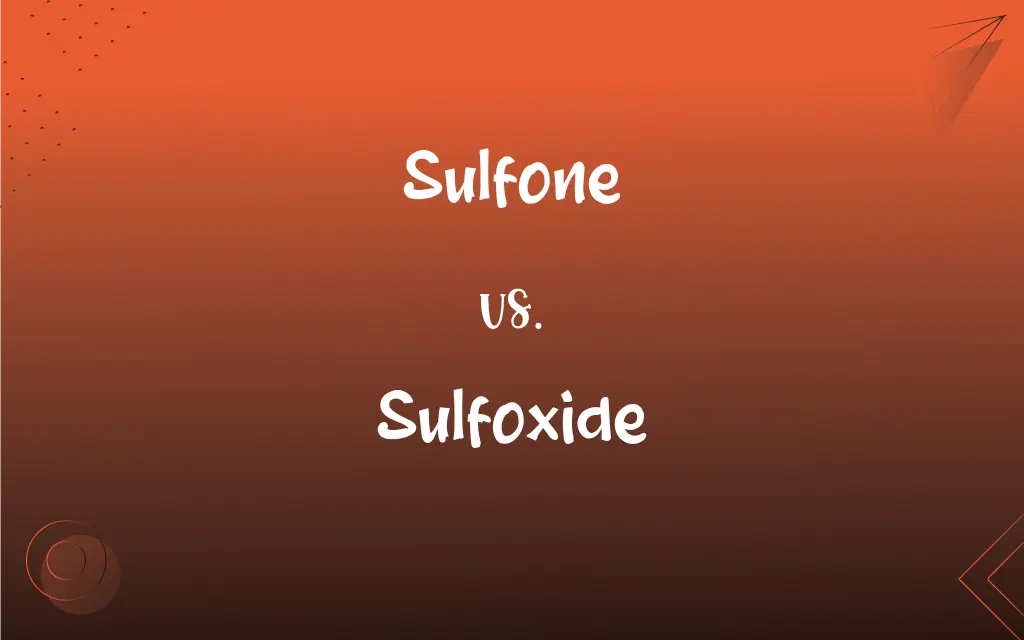Sulfone vs. Sulfoxide: What's the Difference?
Edited by Aimie Carlson || By Janet White || Published on January 17, 2024
Sulfones contain a sulfur atom bonded to two oxygen atoms and two carbon atoms, whereas sulfoxides have a sulfur atom bonded to one oxygen atom and two carbon atoms.

Key Differences
Sulfones and sulfoxides are both organic sulfur compounds. Sulfones are characterized by a sulfur atom doubly bonded to two oxygen atoms and singly bonded to two carbon atoms. In contrast, sulfoxides feature a sulfur atom bonded to one oxygen atom via a double bond and two carbon atoms via single bonds.
The chemical stability of sulfones is generally higher than that of sulfoxides. This is due to the double bonds with oxygen in sulfones, which make them less reactive. Sulfoxides, with their single double bond to oxygen, are comparatively more reactive.
Sulfones are often used in various industrial applications, including as solvents and in pharmaceuticals, owing to their stability. Sulfoxides, however, are more frequently used in organic synthesis as they can act as ligands or intermediates due to their reactivity.
In terms of solubility, sulfones tend to be more soluble in polar solvents compared to sulfoxides. This difference in solubility can be attributed to the distinct electronic structures of these compounds.
The synthesis methods for sulfones usually involve oxidation reactions, while sulfoxides are typically formed through the oxidation of sulfides. This difference in synthesis reflects the unique chemical properties of each compound.
ADVERTISEMENT
Comparison Chart
Oxygen Bonding
Double bonded to two oxygen atoms
Double bonded to one oxygen atom
Reactivity
Less reactive due to double oxygen bonds
More reactive due to single oxygen bond
Industrial Applications
Used in solvents, pharmaceuticals
Used in organic synthesis, ligands
Solubility
More soluble in polar solvents
Less soluble compared to sulfones
Synthesis Method
Typically through oxidation reactions
Formed by oxidizing sulfides
ADVERTISEMENT
Sulfone and Sulfoxide Definitions
Sulfone
A stable chemical group in pharmaceuticals and solvents.
Sulfone polymers are known for their thermal and oxidative stability.
Sulfoxide
A sulfur-containing organic compound with one oxygen atom double bonded to sulfur.
Dimethyl sulfoxide is a popular sulfoxide solvent in chemical reactions.
Sulfone
A sulfur-containing organic compound with two oxygen atoms double bonded to sulfur.
Dimethyl sulfone is a sulfone used in some dietary supplements.
Sulfoxide
A compound involved in the oxidation of sulfides.
The conversion of sulfides to sulfoxides is a common reaction in organic synthesis.
Sulfone
A compound used in the synthesis of various drugs.
Dapsone, a sulfone, is commonly used in the treatment of leprosy.
Sulfoxide
A functional group in chemical synthesis and pharmaceuticals.
Sulfoxides play a crucial role in the synthesis of certain drugs.
Sulfone
A chemical moiety used in high-performance plastics.
Sulfone-based plastics exhibit excellent toughness and stability.
Sulfoxide
A reagent in organic chemistry known for its polar character.
Sulfoxides are often used to increase the polarity of a substance.
Sulfone
A group in organic chemistry characterized by a sulfur atom bonded to two oxygens and two carbons.
In the sulfone group, the sulfur atom is tetrahedral in shape.
Sulfoxide
A chemical group characterized by a sulfur atom bonded to an oxygen and two carbons.
In sulfoxides, the sulfur atom has a pyramidal geometry.
Sulfone
Any of various organic sulfur compounds having a sulfonyl group attached to two carbon atoms.
Sulfoxide
Any of various organic compounds that contain a sulfinyl group.
Sulfone
(organic chemistry) Any of a class of organic compounds that have a sulfonyl functional group attached to two carbon atoms; drugs of this structure have been used to treat leprosy.
Sulfoxide
A sweet-smelling viscous yellow oil, C18H28O3S, used as a synergistic insecticide.
Sulfoxide
(organic chemistry) Any compound of general formula R2S=O.
FAQs
What are sulfones?
Sulfones are organic sulfur compounds with a sulfur atom doubly bonded to two oxygen atoms.
How are sulfoxides formed?
Sulfoxides are formed by oxidizing sulfides.
Are sulfones stable?
Yes, sulfones are chemically stable due to their structure.
Can sulfones be used as solvents?
Yes, some sulfones are used as solvents due to their stability.
What is the reactivity of sulfones compared to sulfoxides?
Sulfones are less reactive than sulfoxides due to their double oxygen bonds.
What are sulfoxides?
Sulfoxides are organic sulfur compounds with a sulfur atom bonded to one oxygen atom via a double bond.
How are sulfones synthesized?
Sulfones are typically synthesized through oxidation reactions.
Are sulfoxides used in organic synthesis?
Yes, sulfoxides are frequently used in organic synthesis due to their reactivity.
Is the solubility of sulfones and sulfoxides different?
Yes, sulfones are generally more soluble in polar solvents than sulfoxides.
Can sulfoxides be used as ligands in reactions?
Yes, sulfoxides can act as ligands in certain chemical reactions.
What is a common use of sulfoxides?
Sulfoxides are commonly used as intermediates in chemical reactions.
What kind of geometry does the sulfur atom in a sulfone have?
In sulfones, the sulfur atom typically has a tetrahedral geometry.
Are sulfones used in plastic production?
Yes, certain high-performance plastics are made using sulfone groups.
Can sulfoxides be converted back to sulfides?
Yes, sulfoxides can be reduced back to sulfides under certain conditions.
What is the geometry of sulfur in sulfoxides?
The sulfur atom in sulfoxides usually has a pyramidal geometry.
Do sulfones react easily?
No, sulfones are less reactive due to their double bonds with oxygen.
Do sulfones have pharmaceutical applications?
Yes, sulfones are used in the synthesis of various drugs.
Are sulfoxides polar compounds?
Yes, sulfoxides are polar due to their functional group.
What makes sulfoxides reactive?
The single double bond to oxygen in sulfoxides contributes to their reactivity.
Are sulfones and sulfoxides found in nature?
Some sulfones and sulfoxides can be found in nature, but many are synthetically produced.
About Author
Written by
Janet WhiteJanet White has been an esteemed writer and blogger for Difference Wiki. Holding a Master's degree in Science and Medical Journalism from the prestigious Boston University, she has consistently demonstrated her expertise and passion for her field. When she's not immersed in her work, Janet relishes her time exercising, delving into a good book, and cherishing moments with friends and family.
Edited by
Aimie CarlsonAimie Carlson, holding a master's degree in English literature, is a fervent English language enthusiast. She lends her writing talents to Difference Wiki, a prominent website that specializes in comparisons, offering readers insightful analyses that both captivate and inform.







































































